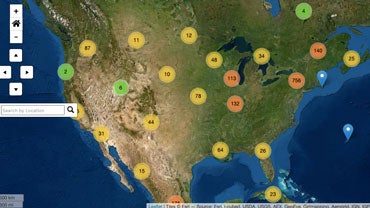
The Catalogus defunctorum is a tremendous resource for studying Jesuit history, listing more than 30,000 Jesuits who died between 1814 and 1970. It provides details about each such as their dates of birth, death, and entry into the Jesuit order, and the Jesuit province where they served.
A new database, Jesuit Online Necrology, provides access to digitized information from the Catalogus defunctorum to make it more useful for researchers. For example, while it’s relatively easy to look up an individual Jesuit in the printed book, the database allows a researcher to track Jesuits across time or search by a specific year or a specific province.
“I knew we had a wealth of material, but I wanted to find ways to make it more accessible,” said Adrian Vaagenes, digital and archival services librarian for Woodstock Theological Library. At the 2019 Symposium for Advanced Jesuit Studies, Vaagenes met Seth Meehan of the Institute for Advanced Jesuit Studies at Boston College (BC), and they jointly developed the idea for the database.
Woodstock and BC partnered to create the database with the cooperation of the Archivum Romanum Societatis Iesu. First, students at Georgetown and BC transcribed the data from the printed book. “COVID actually moved the project along faster than we anticipated, because this task was something students could work on from home,” Vaagenes explained.
Transcription was completed in fall 2020, after which the project team created data for the locations represented in the database. “The Catalogus is complicated because the locations in it have changed over time,” Vaagenes said. “Place names might change or be a part of a different country than they were originally, and World War II made it immensely complicated.” Megan Martinsen, head of Georgetown University Library’s Digital Scholarship unit, made use of a Google app that provided GPS data for these locations.
Boston College used that information to develop the database and host it at their Portal to Jesuit Studies. Matthew Naglak, BC Library’s digital scholarship librarian, also developed some visualizations to show the potential of the database, including a map that visualizes individual Jesuits’ lives by their birthplace, place of entry, and place of death; and a timetable that shows which dates are most common for Jesuit admissions and final vows. “That was a research question we didn’t even know to ask until we saw it,” Vaagenes said.
“But it turns out there are reasons to choose specific days for vows—they relate to Catholic feast days, the celebration of the Assumption of Mary, or the anniversary of the formation of the Jesuits,” Vaagenes said. The database should be valuable for both Jesuit scholars and genealogists. And while there are no formal plans yet for future development, the project team may ultimately expand pages for individual Jesuits by adding photos or obituaries, or add records for other Jesuits who died outside the database’s current 1814–1970 scope.
